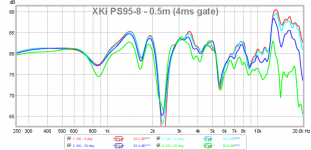At 700Hz that is way too low to say it is where the driver transitions from pistonic to cone break up mode for HF's.
Not according to the designer.
All FRs are in break-up mode to have any HF at all.
dave
Actually, I suggested the same thing earlier in this thread but told by the Expert that it is otherwise, and related to the pistonic transition:
What RA7 said is completely consistent with the meaning of what i said.
Allwe can say from your comment is that you do not yet understand the terminology.
dave
The K-aperture can really improve polar response
So I have an XKi enclosure designed for the RS100-4 so I stuck the PS95-8 in it for fun. It actually sounds decent with some usable bass. I took a polar and was really surprised how uniform it is. Although there is a deep notch at 2.4kHz, it is narrow and my ears don't miss it.
PS95-8 in XKi, at 0.5m and 4ms gate:
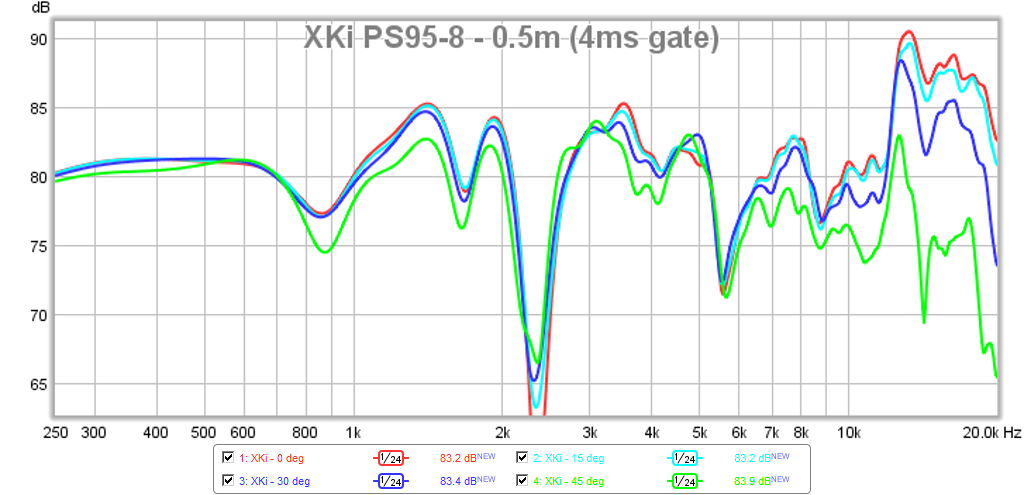
For comparison, here is bare faced PS95-8 in the Nautaloss as previously measured:
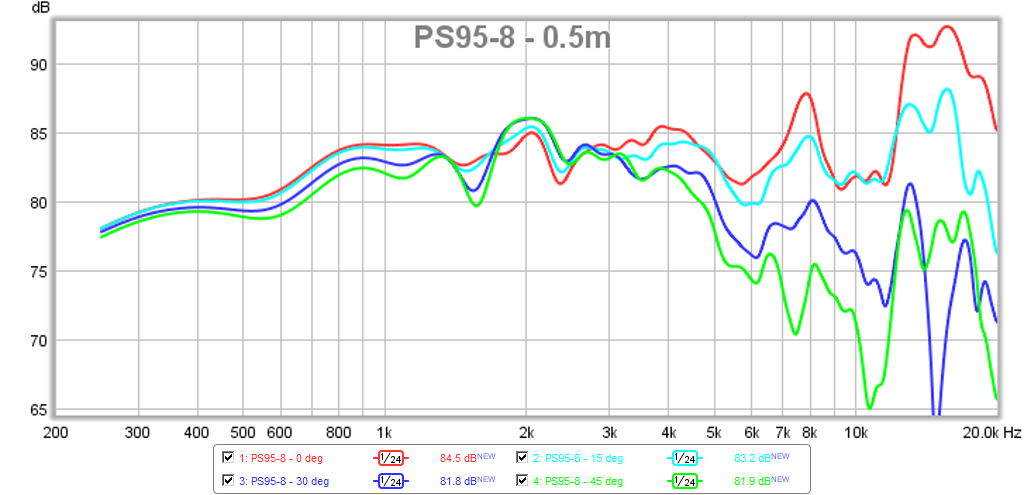
Response and HD of PS95-8 in XKi (200 ms gate):
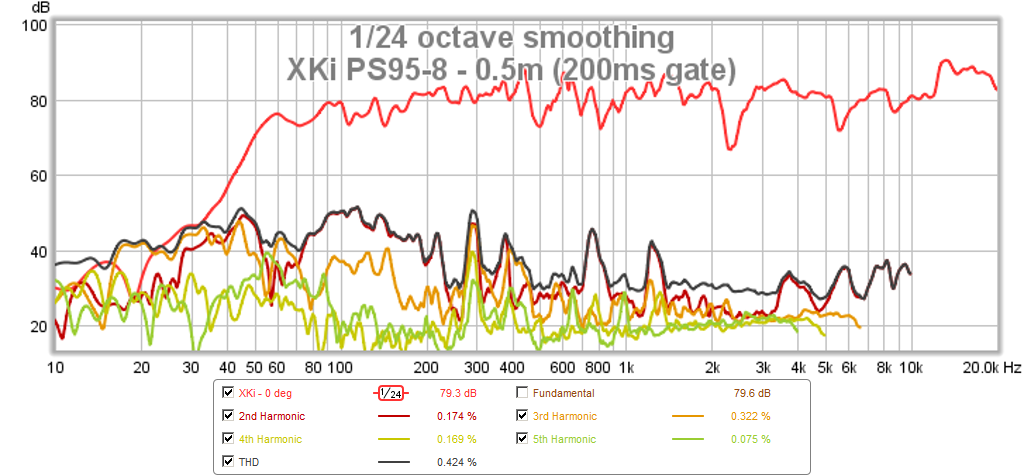
So I have an XKi enclosure designed for the RS100-4 so I stuck the PS95-8 in it for fun. It actually sounds decent with some usable bass. I took a polar and was really surprised how uniform it is. Although there is a deep notch at 2.4kHz, it is narrow and my ears don't miss it.
PS95-8 in XKi, at 0.5m and 4ms gate:

For comparison, here is bare faced PS95-8 in the Nautaloss as previously measured:

Response and HD of PS95-8 in XKi (200 ms gate):

Attachments
Last edited:
xrk the question about the little vifas (newer is hotter at the top) was
because of something I read on the Manzanita thread from the designer. He uses
different components in the notch filter with the new drivers than the old.
I have no experience with them myself but consider the use of four in a vertical array.
Do you think that the combing would lop off the top peak?
thanks
because of something I read on the Manzanita thread from the designer. He uses
different components in the notch filter with the new drivers than the old.
I have no experience with them myself but consider the use of four in a vertical array.
Do you think that the combing would lop off the top peak?
thanks
Reg. the above its worth looking again at Rutchos site for a reality check with other similar drivers (other than X's).
http://rutcho.com/speaker_drivers/default.html
The CHN isn't really bad at all.
http://rutcho.com/speaker_drivers/default.html
The CHN isn't really bad at all.
Reg. the above its worth looking again at Rutchos site for a reality check with other similar drivers (other than X's).
Loudspeaker Raw Driver Measurements
The CHN isn't really bad at all.
Which driver were you suggesting to compare the CHN-70 with on Rutcho's website? Also, the Japanese website linked above only said something about 14 liter box volume being considered - is there more?
might have been the 10P Mark Audio Alpair 10P-A Loudspeaker Measurements and Information
hey Squeak - is there a LCR trap schematic for CHN70?
hey Squeak - is there a LCR trap schematic for CHN70?
Last edited:
Which driver were you suggesting to compare the CHN-70 with on Rutcho's website? Also, the Japanese website linked above only said something about 14 liter box volume being considered - is there more?
The whole last half from "Reproduction frequency characteristic "?
As for what drivers to compare to? Quite a few but some of the most obvious ones are the Pioneer(s), the Fostex 105 WK and of course many of the 8 drivers that have weird behavior from breakup point but sound wonderful anyway.
Ok, but do any of the other fullrange drivers have a breakup point starting at 700Hz followed by a sudden fall off at 7kHz? Literally a square top plateau covering the entire telephone band. Might be great as a center channel for dialog but is very shouty sounding for me to listen to more than 5 minutes.
any of the other fullrange drivers have a breakup point starting at 700Hz followed by a sudden fall off at 7kHz?
It is not a breakup, it is the transition point between pistonic and resonant behaviour,
CHP70.2 is similar.
dave
When a cone stops behaving as a piston, it has higher order transverse vibrational modes, yes they are resonant with higher eigenmodes - and this is the same as breakup. Non pistonic is same as cone breakup. Usually characterized by resonant mode peaks, aka, breakup mode peaks. A 4in cone usually doesn't go into breakup modes until about 7khz. Sort of corresponds with the right cliff of the plateau on the CHN70. Maybe the cone is so thin on the MA drivers that they go non pistonic much earlier. If so, breakup is happening at 700Hz. The majority of the bandwidth of the MA driver is then non pistonic higher order transverse vibrational modes. This would explain why the polars are uniform - it is acting like a BMR above 700Hz, and it explains why the amplitude response is not flat, the various vibrational modes are coming in and out of resonance.
I have the same theory about the nice polar response of Marks drivers, IE that a bit of BMR action is going on above the transition point.
Japanese page suggesting corrections to CHN-70
Google Oversæt
Squeak,
Thanks for the link - when I looked at it on my phone, could not make sense. On the PC, it is very clear now. They basically captured the same frequency response curve that I did and even talk about a plateau from 700Hz to 6kHz as 'the characteristic' of this driver. I now have independent confirmation of the frequency response - and it is nothing like the factory spec graph.
Here is what the link says (Google translated from Japanese):
Frequency characteristics when the above estimate the condition we have is as follows. The characteristics, seems 700Hz ~ 6KHz is about 6dB level have come up with a high baffle step effect. Peak to 5.5KHz, dip is seen in 7KHz around here I think that it is the characteristics of the sound quality of this unit.
Here is the measured frequency response from the same link:
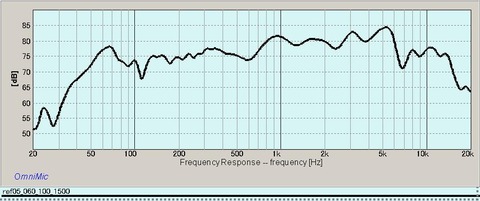
For handy comparison, here is what I measured:
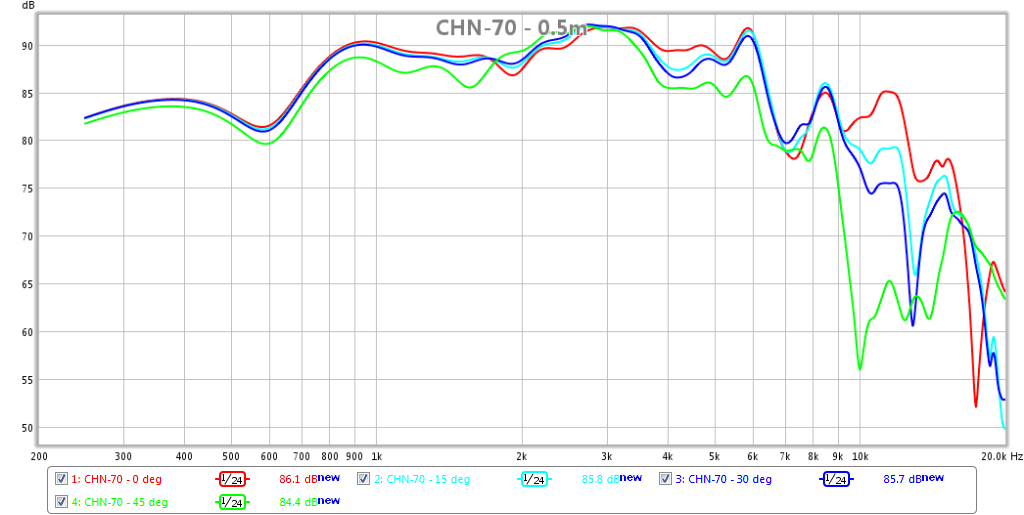
And in fact, they go on to describe the -9dB (same level that I observed as needed) EQ'ing needed to make it work - sort of what I said that it is unlistenable without EQ:
As equalizer to correct the 700Hz ~ baffle step effect and 5.5KHz of 6KHz, it indicates 1KHz in -5dB, -5dB in 2KHz, the frequency characteristics of the case that was corrected by -9dB in 4KHz below.
With the resulting response now looking like this:
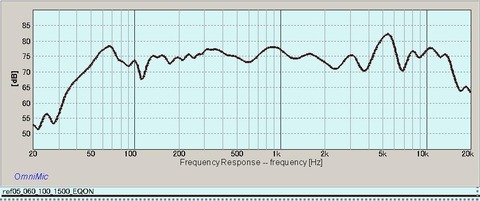
Last edited:
Why is this not evident in the response of the other drivers then, for example the Visa?To be a FR driver it has to transition from pistonic to resonant behaviour at some point. The inflection point is at the impedance bump on the MAs.
dave
I say bingo!When a cone stops behaving as a piston, it has higher order transverse vibrational modes, yes they are resonant with higher eigenmodes - and this is the same as breakup. Non pistonic is same as cone breakup. Usually characterized by resonant mode peaks, aka, breakup mode peaks. A 4in cone usually doesn't go into breakup modes until about 7khz. Sort of corresponds with the right cliff of the plateau on the CHN70. Maybe the cone is so thin on the MA drivers that they go non pistonic much earlier. If so, breakup is happening at 700Hz. The majority of the bandwidth of the MA driver is then non pistonic higher order transverse vibrational modes. This would explain why the polars are uniform - it is acting like a BMR above 700Hz, and it explains why the amplitude response is not flat, the various vibrational modes are coming in and out of resonance.
XRK
Your’e making smoke with “wonky” and “unlistenable”. I’m a musician 22 years concert experience (piano). My ears are Very Keen. My CHN’s are good, comfortable sound, no filters. Like Jim Shearer, I’m enjoying them. Its no crime to enjoy drivers that don’t have flat response. You find 1 CHN driver not to your taste, fine but we don’t have to follow you.
There’s plenty going on the CHN factory frequency graph, dips included. Read this thread, July-August last year:
http://www.diyaudio.com/forums/markaudio/259841-new-driver-chn70.html
Post 1 (Mark)
Post 6 (Mark)
Post 15 (Mark)
A case of personal preference as the CHN70 is good in stock form while responding equally well to equalisation/tuning.
There’s a pic on this post to make the dip obvious to all. You’re pushing your flat driver agenda at any cost. I read Mark is working on surviving cancer. Give the guy some breathing space.
Your’e making smoke with “wonky” and “unlistenable”. I’m a musician 22 years concert experience (piano). My ears are Very Keen. My CHN’s are good, comfortable sound, no filters. Like Jim Shearer, I’m enjoying them. Its no crime to enjoy drivers that don’t have flat response. You find 1 CHN driver not to your taste, fine but we don’t have to follow you.
There’s plenty going on the CHN factory frequency graph, dips included. Read this thread, July-August last year:
http://www.diyaudio.com/forums/markaudio/259841-new-driver-chn70.html
Post 1 (Mark)
Performance: This response for this driver is reasonably flat. Due to the relative low mass, some variations can be observed in the frequency spectrum. Likely once inside a box, a rolling off from around 8kHz will likely occur. It shouldn't be a pronounced as the current CHP70 model, which incidentally is selling remarkably well. The CHN-70 is intended for budget general diy/home audio applications where longer listening sessions require a "neutral" sound. Those users who wish to boost the CHN-70's upper responses will find it very adaptable, easily driven up by active equalisation. For those users who want more in-built "fizz" at the top end, the CHR70 Gen.3 would be more suited.
Post 6 (Mark)
Hi Big,
Thanks. Its interesting in Japan as this time where early adopters are doing quite well with CHN. Understandably, its being compared to the 103En but its viewed a quite a different animal. The thinking is the CHN is better in the low and middle, the Foss for the highs. I'd say this is about right as there's no point me repeating a design like the 103.
The interesting experimenting happens for those with active filtering/equalisation. There I believe the CHN has the edge since it retains the Markaudio long-throw design, much easier to tweak the top end knowing you've got coil length to play with in the lower frequencies. No offence to Foss users, its just my design thinking which is an alternative to more traditional high SPL short stroke designs.
Post 15 (Mark)
Hi Guys,
I've received several email requests for more information on the CHN's higher range performance, see graph pic. You can observe the the flattening off and down from around 8kHz.
The CHN70 is designed to perform in this manner. This driver is about producing a "neutral/natural" sound. Interestingly, its already gaining allot of discussion in Japan. Some are keeping the drivers "stock" characteristics, others are applying anything from +3dB to +6dB gain/boost from around 8kHz.
As said in a previous post, if you want a brighter top end, CHR70, Alpair 7M and soon to be Alpair 7P all provide this type of characteristic, so the CHN-70 provides for those users on a budget who want a more mellowed sound characteristic.
A case of personal preference as the CHN70 is good in stock form while responding equally well to equalisation/tuning.
There’s a pic on this post to make the dip obvious to all. You’re pushing your flat driver agenda at any cost. I read Mark is working on surviving cancer. Give the guy some breathing space.
Last edited:
linspire,
Please, had CHN70 datasheet been showing real performance xrk971 hadn't bought it at all because it not his performance target. All these excuses you and scottmose points out that the info should be public and well known bla bla bla is only found where you linked, well what about printing it in the datasheet or at their real public web site Markaudio.
Heck the impedance curve is >75% out of spec at 700Hz, well I'm working with production if we deliver products that long from what we promised, ohh.
See at post 94 you say "no way they drop off so much around 6khz" then at post 138 you accept objective measured data and say "Its no crime to enjoy drivers that don’t have flat response". Are you not also a little disappointed the out of spec performance you have put your money into.
Really understand you care for his health we all do and like to survive, lets wish Mark the best.
EDIT CHN70 ended up a solid performer off axis, thumps up that one.
Please, had CHN70 datasheet been showing real performance xrk971 hadn't bought it at all because it not his performance target. All these excuses you and scottmose points out that the info should be public and well known bla bla bla is only found where you linked, well what about printing it in the datasheet or at their real public web site Markaudio.
Heck the impedance curve is >75% out of spec at 700Hz, well I'm working with production if we deliver products that long from what we promised, ohh.
See at post 94 you say "no way they drop off so much around 6khz" then at post 138 you accept objective measured data and say "Its no crime to enjoy drivers that don’t have flat response". Are you not also a little disappointed the out of spec performance you have put your money into.
Really understand you care for his health we all do and like to survive, lets wish Mark the best.
EDIT CHN70 ended up a solid performer off axis, thumps up that one.
Last edited:
XRK
Your’e making smoke with “wonky” and “unlistenable”. I’m a musician 22 years concert experience (piano). My ears are Very Keen. My CHN’s are good, comfortable sound, no filters. Like Jim Shearer, I’m enjoying them. Its no crime to enjoy drivers that don’t have flat response. You find 1 CHN driver not to your taste, fine but we don’t have to follow you.
There’s plenty going on the CHN factory frequency graph, dips included. Read this thread, July-August last year:
http://www.diyaudio.com/forums/markaudio/259841-new-driver-chn70.html
Post 1 (Mark)
Performance: This response for this driver is reasonably flat. Due to the relative low mass, some variations can be observed in the frequency spectrum. Likely once inside a box, a rolling off from around 8kHz will likely occur. It shouldn't be a pronounced as the current CHP70 model, which incidentally is selling remarkably well. The CHN-70 is intended for budget general diy/home audio applications where longer listening sessions require a "neutral" sound. Those users who wish to boost the CHN-70's upper responses will find it very adaptable, easily driven up by active equalisation. For those users who want more in-built "fizz" at the top end, the CHR70 Gen.3 would be more suited.
Post 6 (Mark)
Hi Big,
Thanks. Its interesting in Japan as this time where early adopters are doing quite well with CHN. Understandably, its being compared to the 103En but its viewed a quite a different animal. The thinking is the CHN is better in the low and middle, the Foss for the highs. I'd say this is about right as there's no point me repeating a design like the 103.
The interesting experimenting happens for those with active filtering/equalisation. There I believe the CHN has the edge since it retains the Markaudio long-throw design, much easier to tweak the top end knowing you've got coil length to play with in the lower frequencies. No offence to Foss users, its just my design thinking which is an alternative to more traditional high SPL short stroke designs.
Post 15 (Mark)
Hi Guys,
I've received several email requests for more information on the CHN's higher range performance, see graph pic. You can observe the the flattening off and down from around 8kHz.
The CHN70 is designed to perform in this manner. This driver is about producing a "neutral/natural" sound. Interestingly, its already gaining allot of discussion in Japan. Some are keeping the drivers "stock" characteristics, others are applying anything from +3dB to +6dB gain/boost from around 8kHz.
As said in a previous post, if you want a brighter top end, CHR70, Alpair 7M and soon to be Alpair 7P all provide this type of characteristic, so the CHN-70 provides for those users on a budget who want a more mellowed sound characteristic.
A case of personal preference as the CHN70 is good in stock form while responding equally well to equalisation/tuning.
There’s a pic on this post to make the dip obvious to all. You’re pushing your flat driver agenda at any cost. I read Mark is working on surviving cancer. Give the guy some breathing space.
Linspire,
First, as a matter of forum etiquette and diyAudio rules, don't use all bold or caps in your replies in the future. It is akin to SHOUTING. We don't need to raise our voices here is a discussion of "objective comparisons".
Secondly, I don't have an "agenda" here for flat performance in the response. There are 6 other drivers tested, many of which are not flat. My point is that drivers should be close to what their specs are advertised to be.
The term "wonky" was what Planet10 ascribed to my measurement of the CHN70, I was simply relaying that term right back since it turns out that there is nothing wrong with my measurement.
I won't dispute your "keen" ears as a practicing musician for 22 years. Please present objective data if you have issue with my findings.
The fact that the driver is "unlistenable" to me, I suppose is not technically objective. But a driver that has a square top plateau of +9dB off nominal and claims to be a "full range" with "neutral" character is neither full range or neutral. In fact, I thought mine was a defective unit and was about to request an exchange. But it turns out that it is just designed that way, but it wasn't specified that way in the data sheet. So I will just have to return my drivers for refund, because they are technically not anywhere performing close to the targeted official spec's.
I have no argument with you if you enjoy the CHN70, and you keep citing Jim Shearer who enjoys them too. I respect his opinions as I do all folks who say they like the sound. He also said something like "One measurement is worth a thousand expert opinions."
As Byrtt pointed out - what we are discussing here is objective evidence. If you have issue with any of my findings then present some evidence or measurement or data. The measurement performed by the Japanese and shared by Squeak is an example of evidence. In this case, in my favor.
I hope that you see that I am presenting data for all drivers in a fair and balanced way. There are 6 other drivers here and they also have warts in their data - but their warts MATCH their published specs. It is simply not reasonable to expect to be able to sell a product in this age where users are easily able to measure and confirm performance to not provide accurate data in the official spec sheet.
Let me say that it's like buying another electronic product like computer advertised to have 4GHz clock speed and 1MB cache memory to find out upon running diagnostic in bios that it can't run faster than 3.5GHz and the cache was Mis specified and is really only 512k. If I wanted to buy a 3.5GHz 512k cpu computer - that would have been the spec I looked for.
For all folks responding in this thread, please keep the discussions on topic by presenting "Objective" data in response and not just a lot of talk, opinions, anecdotes, or complaints.
Last edited:
- Status
- Not open for further replies.
- Home
- Loudspeakers
- Full Range
- An Objective Comparison of 3in - 4in Class Full Range Drivers
